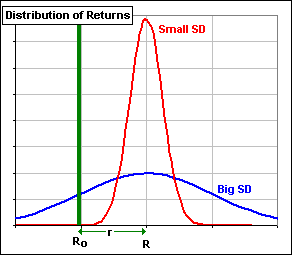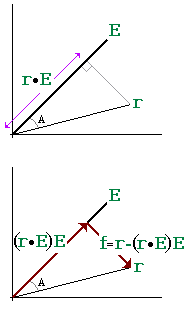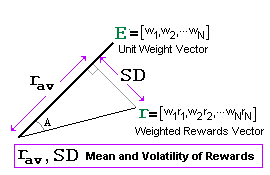| Sharpe ratio ... and related stuff. |
In an interesting paper
(in .PDF format), Victor Norton (Bowling Green State University) considers variations on the Sharpe Ratio in order to decide when to switch allocations from one set of
assets to another and ...
>Sharpe Ratio?
Yes. If your average portfolio return is R and a risk-free return is Ro (for example, cash or money market),
then the excess is r = R - Ro.
That excess is what you get for accepting the risk associated with the risky assets in your portfolio.
It's your Reward and you'd expect R
to be greater than Ro (unless your portfolio is entirely in risk-free assets).
|
>That r is the Sharpe Ratio? Not yet. If the Volatility or Standard Deviation (SD) of your portfolio is small, then you should be happy. Chances are you'll get the Reward r. On the other hand, if your portfolio assets are volatile (so SD is large) then there's a good chance you may get a return less than the risk-free return, Ro. The Sharpe Ratio measures Reward/Volatility, that is
It'll have a larger Sharpe Ratio, if that's what you mean. That's because the Volatility = SD is small. >But both the red and blue guys have the same Reward, eh? Yes, because they have the same Mean (or Average) Return R. |  Figure 1 |
>So what does Norton do? Maximize the Sharpe Ratio?
Not exactly. The question is: What to use as the Portfolio Return R?
>You said it was the Average Return, so why not just ...?
But there are averages and averages. For example, if the returns over the last N months were R1, R2, ... RN, where R1 is the most recent and RN the most remote (N months ago), then the average ...
>It's (1/N)(R1+R2+ ...+RN), right?
That's one kind of average; the garden variety Arithmetic Mean. However, the are lots of Weighted Averages.
For example, you may want to place more weight on the more recent returns. In general, if you want a Weighted Average of N returns, then:
- Pick N weights w1, w2, ... wN which add to "1" (that is, w1+w2+ ...+wN=1)
- Calculate a Weighted Average = w1R1 + w2R2 + ... + wNRN.
- Note that, if all returns are equal to, say, R, the Weighted Average = w1R+w2R+...+wNR = R
which explains why the weights must add to "1".
>What's "best"?
Aah, that's the question, but ...
>And what if your portfolio has several assets? What's the "best" allocation then?
Okay, but first consider Norton's weighted average ritual with a single stock (or mutual fund):
- If r2, ... rN are the monthly rewards ... meaning: (monthly stock return) - (monthly risk-free return), then
- rav = W1r1+W2r2+...+WNrN is the weighted average reward (for that stock).
- If we let w1 = SQRT[W1], w2 = SQRT[W2], etc. be the Square Root of the weights,
then rav, which is the sum of products, can be written as
rav = w1(w1r1)+w2(w2r2)+...+wN(wNrN) - Following Norton, we introduce a vector E with N components w1, w2, ... wN: E = [w1, w2, ... ,wN]
- The length of this vector is ||E||
= SQRT(w12+w22+...+wN2)
= SQRT(W1+W2+...+WN) = SQRT(1) = 1
(since the weights add to "1"). Hence E is a unit vector.
- In addition, we introduce another vector: r = [w1r1,w2r2,...,wNrN].
- With these two vectors we can write the (weighted) average stock reward as a dot product (or scalar product):
rav = r E
(meaning we add the product of components of E and r)
E
(meaning we add the product of components of E and r)
|
>Huh? If these two vectors, E and r, were 2-dimensional, they might look like Figure 2A 
The DOT product gives the (product of their lengths)*(the cosine of the contained angle):
Further, the vector r is the sum of two vectors:
Further. the length of f = r - (r |  Figure 2A and Figure 2B |
>Huh?
Remember, the Variance is the average squared deviation of the monthly rewards from the average reward.
That is:
Variance = ΣWk[rk - rav]2 = ΣWk[rk2 - 2rkrav + rav2] = ΣWkrk2 - 2ravΣWkrk + rav2ΣWk = ΣWkrk2 - 2ravrav + rav2(1)
That is:
Variance = ΣWkrk2 - rav2 = (the Average Square) - (the Square of the Average).
>You're talking "weighted" averages, eh?
Yes. Didn't I say that? Pay attention.
>Okay, but that's just for 2-dimensional vectors. That means just two months of rewards and ...
Actually, I lied. It's for any number of months. In fact, the 2-D part comes from the fact that we just looked at
the plane defined by E and
r ... as in Figures 2 and 3 (below).
>That's pretty slick, eh?
Isn't it! Notice that, if we refer to the Standard Deviation as "Risk" (as Sharpe does), then "Risk" and "Reward" are orthogonal.
Indeed, we can now write:
|  Figure 3 |
>But we're talking a single asset, eh?
So far, yes. But our single, weighted reward vector r could be the reward associated
with a single portfolio which just happens to have umpteen components.
>Huh?
Here we consider a portfolio with M assets:
- Our portfolio has fractions x1, x2, ... xM devoted to each.
- With assets "1" to "M" we associate (weighted) reward vectors
r1, r2, ...
rM
where rj = fj + (rj E)E
= fj + ravjE
(j = 1, 2, ... M)
E)E
= fj + ravjE
(j = 1, 2, ... M)
- Our portfolio reward vector is then:
r = x1r1 + x2r2+ ... + xMrM = Σxjrj = Σxjfj + (Σ(xj rj) E)
E
= f
+ (r
E)
E
= f
+ (r E)E
= f + ravE
E)E
= f + ravE
where rav = Σxj ravj is the average portfolio reward.
>The "weighted" average, eh?
Yes. Do I have to keep saying that? If you'd just pay ...
>It's like the single investment case. I guess the Sharpe Ratio for your portfolio is rav / ||f||, eh?
Very good. In fact, ||f|| is the Standard Deviation for our portfolio and
||f||2
= f f
= Σxjfj
f
= Σxjfj Σxkfk
is a sum of products of our fractions xj, containing stuff involving x12 and
x1x3 and x7x5 and ...
Σxkfk
is a sum of products of our fractions xj, containing stuff involving x12 and
x1x3 and x7x5 and ...
>Okay. I get the idea.

